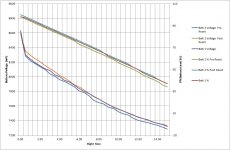I have done another test with my 2 batteries. Battery 1 came with the Anafi and I bought Battery lightly used from another forum member a while ago. I did a battery reset on Battery 2 to see whether the figures would alter. Neither battery has been heavily used or run down to RTF or autoland voltages.

The batteries show a good corrolation in both % and voltage. It was a still day today and about 8 degrees. The Battery 2 test pre reset was done in about slight wind at the same temperature. The flights were made within 1 hour of the batteries being charged throgh the USB-C port using a PD wall charger. All of the tests are a simple hover 1m above ground for 15 minutes and then land. Both battery voltages have recovered to about 7.6v.
I am beginning to think that the % battery reported by FF6 6.6.2 is related more to the time of flight than the actual battery voltage. If we assume that the battery will go from a reported 100% to 0% in 25minutes (Parrot advertised maxiumum flight time) then this equates to 4% used/min which is approximately what the graphs above are showing.
As an aside I did have 2 cases, both with battery 2, when the gimbal would not initialise properly and it ended up facing the sky. It has done this once before a long while ago. Rebooting the Anafi cured the problem.

The batteries show a good corrolation in both % and voltage. It was a still day today and about 8 degrees. The Battery 2 test pre reset was done in about slight wind at the same temperature. The flights were made within 1 hour of the batteries being charged throgh the USB-C port using a PD wall charger. All of the tests are a simple hover 1m above ground for 15 minutes and then land. Both battery voltages have recovered to about 7.6v.
I am beginning to think that the % battery reported by FF6 6.6.2 is related more to the time of flight than the actual battery voltage. If we assume that the battery will go from a reported 100% to 0% in 25minutes (Parrot advertised maxiumum flight time) then this equates to 4% used/min which is approximately what the graphs above are showing.
As an aside I did have 2 cases, both with battery 2, when the gimbal would not initialise properly and it ended up facing the sky. It has done this once before a long while ago. Rebooting the Anafi cured the problem.



